Parade Street, is located in the the centre of Yarmouth.
Once one of the showiest streets of the town, Parade Street has changed
drastically. The mansion known as Brookside, located, as it was,
beside the stream on Parade Street, was demolished. The handsome Yarmouth
Academy was lost to fire. Other fine homes were converted to
apartments and are hardly recognizable today from their modern counterparts..
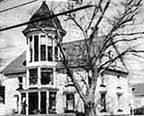
|
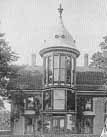 The
Lovitt House, 10 Parade Street. The
Lovitt House, 10 Parade Street.
This house
was built in 1862 by John Lovitt. The house was an classic example of the
Georgian style. In 1891 a huge three story glass and wood tower was added.
The tower was and still is used as a greenhouse. The house is two 1/2 stories
high with small tooth like wood work around the eaves. This
is one of Yarmouth's best known landmarks. Next door to this house is a
fine example of Italian architecture, the house is well preserved. |
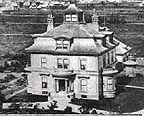
|
The Yarmouth Academy, Parade
Street.
Captain John Killam Ryerson built this magnificent $35,000 home on Parade
Street in 1869, importing all the furnishings from England and France.
Designed by a European architect, the house contained 36 rooms and its
spacious halls and broad staircase were finished in oak, walnut and chestnut.
Two men were brought from England to do the fine paneling. The house
and its equally handsome outbuildings stood on vast landscaped grounds.
Capt. Ryerson , who went to sea at an early age, was a successful businessman
and head of Ryerson, Moses & Co. He served as Yarmouth's elected representative
to the first local Assembly formed after Confederation. He died December
19, 1890. In 1898 the home was purchased by the School Commission
for a mere $8,000 and became the Yarmouth County Academy. On February
20, 1949, the school caught fire and, as the news spread, many current
and former students gathered in horror to watch it burn to the ground.
|
Vancouver Street is located in Milton, or
North Yarmouth. Even though many of the beautiful residences are gone,
the street continues to display Yarmouth's historic beauty.
Sadly though, as with Parade Street, homes too large for modern
living were converted into apartments and their character changed.
One such mansion, Fir Banks, was destroyed. Another lost its gingerbread
trim, and its summer kitchen and carriage house are no more. Still,
a visit to Vancouver Street rewards the walker with fine views of the harbour
and a glimpse of Yarmouth's distinguished past.
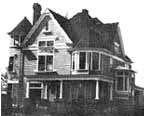
|
"Hillside", 33 Vancouver Street.
The grand house known as "Hillside" was built in 1897 by W. L. Lovitt.
In the Queen Anne Revival style, the house has many interesting architectural
features, including a conical tower, covered porches of wood and stone,
and beautiful stained-glass windows. The Lovitt family of shipowners,
whose ancestor, Andrew Lovitt, was one of the early grantees of the town,
have contributed several outstanding landmarks to Yarmouth, including the
centrepiece of the Lakelawn Motel in Milton, the George and Mary (Lovitt)
Guest house, and the Captain John Lovitt home on 10 Parade Street. |
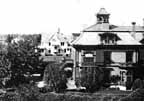
|
"Fir Banks", 31 Vancouver Street.
Situated among other stately homes on Vancouver Street, Fir Banks was
built by Robert Caie in 1869, sometime after his marriage to Matilda Chandler.
The three-story manor boasted spacious landscaped grounds, a circular
drive, outbuildings and an overflowing greenhouse. It was ornate,
down to such details as decorative moldings and carvings over the windows
and gracefully curved dormers. A carved wood and stained-glass
area on the second floor was a later addition. The enclosed widow's
walk gave views far down the harbour. Following the death of her
parents, Miss Clara Caie lived on alone in the house until her own
demise. In the early 1960s this house, one of Yarmouth's finest
examples of the high Victorian period, was demolished to make way for a
more modern home. Sic transit gloria mundi! |

|
The Stayley Brown House, 12
Vancouver Street
This lovely Italianate home, situated at #12 Vancouver Street,
was built in 1864 by a wealthy merchant and ship owner who was an outspoken
opponent of Confederation. The Honourable Stayley Brown served
in the Legislature for 34 years, was president of the Nova Scotia Executive
Council, held the post of Receiver-General, and in 1875 became the Provincial
Treasurer. In the 1990s the house was vacant and had been extensively
damaged by fire. It was saved from certain doom when the Dares
family purchased it in 1995 and restored it to its original stately condition.
In 1997 it was declared a Municipal and Provincial Heritage Property.
It is open year-round by the Dares as the Harbour's Edge Bed & Breakfast. |

|
Home of "the Fuller Brush Man"
Edward B. Cann, a merchant who operated a clothing store at the corner
of Main and Central Streets, built this stately home between 1890 and 1895.
The home, located at 20 Collins Street, , was later owned by the Bown and
Pelton family but was better known in the Twentieth Century as the summer
residence of Primrose (Pelton) and Alfred Fuller – the Annapolis Valley
native who started the Fuller Brush Company. In 1996 the home and
its contents were donated to the Yarmouth County Historical Society and
today it opens seasonally to the public as a heritage home exhibit, focusing
on the Pelton and Fuller families and the Fuller Brush Company. |
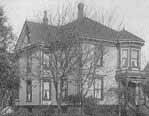
|
The John Murray Lawson Residence
Standing on William Street, this home was built in 1898 by J. Murray
Lawson, whose father, Alexander, established the Yarmouth Herald in 1833.
The house is described as having "a nautical flare", though the Lawsons
were not followers of the sea. Murray became editor of "The
Herald" upon his father's death in 1895, a position he held until his own
death in 1925. Even when the newspaper changed ownership, Miss Laura Lawson,
Murray's daughter, continued to take a lively interest in its operation
and was a regular visitor to the site up to the ‘50s. The Lawson
legacy of journalism has served Yarmouth well. Today the collection
of newspapers and reference works compiled by Murray form the cornerstone
of the Yarmouth County Museum Archives and are used by researchers on a
daily basis. |
|







